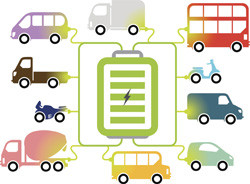Lithium-ion batteries for transport
Energy storage is a rapidly evolving area. Due to their high energy density, the lithium-ion technologies that power today's electronics are becoming the main players for transportation and other energy storage markets. In the EU-funded research project 'High energy lithium-ion storage solutions' (HELIOS)(opens in new window), scientists evaluated four lithium-based battery technologies to find the most promising for the mass market. These were lithium nickel cobalt aluminium (NCA), lithium nickel manganese cobalt (NMC), lithium manganese oxide (LMO) and lithium iron phosphate (LFP). The study was performed on large high-energy cells for EVs, plug-in hybrid EVs and hybrid heavy-duty truck applications. HELIOS team members compared the different battery cell types for performance, life, cost, recycling and safety abuse characteristics — the key issues that should contribute to successful EV commercialisation. Cycling capacity, depth of discharge, state of charge and temperature as well as upper and lower voltages were found to be some of the potential cell ageing mechanisms. Analysis on new, intermediate and final cell samples showed that adhesion was one of the main ageing mechanisms, whereas temperature may cause NMC and LFP dissolution. Studies showed that NMC-based cells have a slightly lower capacity than the NCA ones. However, NMCs may reach equivalent energy density with continuously improving cell materials and cell geometry adaptations. On the other side, LMO–NCA blend cells had significantly lower capacity. Further optimisations in the mass mixture may compensate this disadvantage. With regard to the LFP-based cells, results were rather disappointing, particularly in terms of their life endurance. In addition, the cell capacity can be further increased without sacrificing their advantageous abuse tolerance. This makes them especially interesting for plug-in hybrid EVs with relatively small batteries. The automotive industry is hard-pressed to meet ambitious EU climate and energy targets for 2020, especially for reducing greenhouse gas emissions by 20 %. As such, HELIOS outcomes should greatly help the automotive industry as well as urban transport operators to move in this direction.



